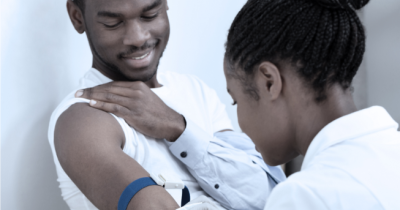How doctors diagnose breast cancer

Last updated on 28th January, 2022 at 10:22 am
Globally, female breast cancer has surpassed lung cancer as the most diagnosed cancer, accounting for 2.3 million of the 19.3 million cancer cases diagnosed in 2020, according to GLOBOCAN 2020 statistics released by the International Agency for Research on Cancer.
Breast cancer is also the most commonly diagnosed cancer in African women, and homing in either further, South African women, too. To add, while breast cancer is far less common in men, it is still diagnosed. According to National Cancer Registry 2017 statistics, breast cancer accounted for nearly 200 of the roughly 40 000 diagnoses in men. One of the great challenges we face in combatting the disease is the survival rate; according to World Health Organization, survival of breast cancer for at least five years after the original diagnosis is as low as 40% in South Africa, compared to higher income countries where it peaks at 90%. Researchers behind a study published in Frontiers in Oncology suggest that poverty, social and cultural barriers, and sometimes limited access to diagnostic and treatment facilities play a combined role in breast cancer not being screened, diagnosed and treated early enough.
Knowing how common breast cancer is in South Africa, it’s understandable that screening for suspicious lumps in breast tissue, while empowering, can also come with a sense of dread. All sorts of thoughts can race through your mind the moment you feel any change in your breast skin or tissue, and could perhaps lead you to procrastinate booking a doctor’s appointment out of fear of the unknown. But it’s what you and your doctor know that can empower you both to get the full picture of your health, and what needs to be done – if anything – to get or keep you on the cancer-free road.
“There is a three-legged approach to the diagnosis of breast cancer, and all three must be used in conjunction with each other, and must agree with each other,” says Prof Jackie Smilg, a radiologist and adjunct professor of radiology at the University of the Witwatersrand. “Much like a three-legged stool needs all three legs to work in unison to keep the stool upright and functional, so must all three ‘legs’ of breast lump diagnosis work together.” She, along with other experts, break down the steps doctors take to confirm a diagnosis of breast cancer and determine the best course of treatment.
Breast cancer detection step #1: Physical screening
This is possibly the easiest part of the process and can save your life. Screening begins with you, and should be done monthly to ensure you notice any changes in your breast tissue or skin. “[For women], try not to do it in the first seven days after your period because your breasts are still a bit more tender and you may miss certain changes,” suggests Dr Mpume Zenda, a gynaecologist and obstetrician. Use this practical guide to conduct a thorough home self-examination for breast lumps.
For women, even if you don’t notice anything suspicious in either of your breasts, it’s still important that your gynae does a physical examination at your annual check-up. “If your gynae only does the pap smear, and not your breast exam, remind them: ‘Doc, please remember to check my breasts’, because sometimes gynaes forget,” says Dr Zenda. “This is simply an extra person who gets to check and see if there’s anything that is abnormal,” she adds.
The other two critical factors worth noting and discussing with your doctor, says Dr Zenda, is your age and any family history of breast cancer. In South Africa, the recommended age at which women should start going for mammograms is 40. A mammogram is an X-ray of the breast, and can provide 2D and 3D imaging.
If you do feel a lump, don’t wait for your next check-up. Book an appointment with your GP or gynaecologist and have it checked out.
Breast cancer detection step #2: Imaging
Ultrasound
So, you’ve detected a lump or any other change in one of your breasts. If you are under 40, and your doctor has done their own physical examination of your breasts, they may prescribe a breast ultrasound to be conducted on both of your breasts. “Sonar (ultrasound) uses sound waves to produce images of structures within the body,” says Prof Smilg. “It is easier to visualise with an ultrasound in younger women, whereas mammogram is more specific, and useful for when you are older,” adds Dr Zenda.
While the idea of being sent for imaging tests can be nerve-wracking, the experts share some comforting facts: “There are different types of breast lumps. Not all are cancerous. Most breast lumps – 80% of those biopsied – are benign (non-cancerous),” says Prof Smilg. A lump could just be a fibroadenoma, which is one of the most common non-cancerous tumours of the breast in women under 30. “If it feels like a mouse (it’s solid and mobile), and is not associated with any other symptoms such as bleeding through the nipple or discharge through the nipple, or changes of the skin around the breast, it’s possibly a fibroadenoma,” explains Dr Zenda. Having an ultrasound done creates a clearer picture to help doctors determine whether it’s a fibroadenoma. A radiologist will do imaging of your breasts and compile a report for your referring doctor to discuss with you.
Mammogram
“The most appropriate imaging technique is determined for each individual according to personal circumstances or risk factors,” says Prof Smilg. “A mammogram may detect breast cancer many years before the tumour can be felt by you or your healthcare professional,” the professor explains. As discussed, if you are over the age of 40, you should be going for annual routine mammograms. If you detect a suspicious change in your breasts during self-examination, don’t delay contacting your doctor.
MRI
Magnetic Resonance Imaging, commonly known as MRI, is an imaging technique that doesn’t use radiation to create the images. Instead, dye is injected into a vein during the procedure, and magnetic and radio waves are used to create pictures of the inside of the breast. “This method is highly sensitive for cancer detection, but has the potential to detect false positives; in other words, its specificity (true negative) is low,” says Dr Poovan Govender, a specialist oncologist at Oncocare. “Breast MRI is useful for evaluating dense breasts in young women; lesions that can be felt but are not seen on other imaging; or when breast cancer cells have been found in underarm lymph nodes, but no tumour can be seen in the breast on other imaging,” he explains.
Breast cancer detection step #3: Biopsy
“A biopsy may be needed and is the only definitive way to make a diagnosis of breast cancer,” says Prof Smilg. If you are not at an increased risk factor for breast cancer and an ultrasound shows that the mass meets the criteria for a fibroadenoma, it’s important to keep monitoring it, but a biopsy isn’t always necessary.
“During a biopsy, the doctor uses a specialised needle device guided by X-ray or another imaging test to extract a core of tissue from the suspicious area,” explains Prof Smilg. This is then sent for analysis at a laboratory to determine whether the cells are cancerous.
Breast cancer detection step #4: Diagnosis
Analysing the biopsied sample under a microscope, pathologists can find out a few things about the tissue:
- Whether it is cancerous;
- If cancerous, the type of cells in the breast cancer;
- The grade or aggressiveness of the cancer;
- Whether the cancer cells have hormone receptors or other receptors that could influence your treatment options.
“The pathology report includes information that is used to calculate the stage of the breast cancer,” says Prof Smilg. “This is used in conjunction with other tests to decide whether the cancer is limited to one area in the breast, or it has spread to healthy tissues inside the breast or to other parts of the body.”
Finding out the stage of breast cancer
Based on the pathology report and imaging, an oncologist will have information about the size of the tumour, as well as type of cells that form it, and how aggressive it is. But since cancer can spread, it is sometimes necessary to take cells from the lymph nodes in the armpit to determine whether this is the case. “The smaller the tumour, the less likely it is to have spread beyond the breast, and the better the chance for successful treatment,” says Dr Govender. “Small tumours are generally classified as two centimetres (20mm) or smaller.”
If the size of the tumour is cause for concern, a biopsy of lymph nodes will be taken, and a pathologist will analyse these to determine whether they are ‘positive nodes’ ie cancerous.
If the cancer cells have spread to lymph nodes, it’s possible these have travelled in your bloodstream to other organs in your body. This is known as ‘metastasis’ or ‘metastatic cancer’. “Imaging such as CT scans and bone scans can be performed if the tumour is high risk and/or metastases are suspected,” says Dr Govender.
Breast cancer detection step #5: Treatment options
As discussed, a team of specialists from different medical disciplines is involved in various steps of the screening and diagnostic process, each bringing to the table a view of the cancer through a different lens. Bringing all information gathered about a case to a multidisciplinary team (MDT) meeting, doctors discuss feasible treatment options considering both patient and disease factors. Patient factors can include their fitness for treatment, while disease factors include the stage of disease, and the hormonal receptor profile of the cancer. “Treatment for breast cancer can be given both locally (surgery and radiation therapy) and systemically (chemotherapy, targeted therapy, hormone therapy),” says Dr Govender. “Each treatment plan is individualised, as no two cases of breast cancer are exactly the same.”
Being financially prepared
Because every breast cancer case is unique, the cost of treatment can vary. Being prepared for the costs means, should you be diagnosed, you can focus on getting better knowing your treatment won’t add financial strain. “Cancer cover is not a replacement for medical aid or gap cover, but these three products complement one another,” says Karen Bongers, product development actuary at Sanlam Individual Life. “It is worth considering all three products in order to be comprehensively covered.” Comprehensive severe illness benefits include cover for cancer, but if you are particularly concerned about your risk for cancer, a top-up of the cancer-only benefit can offer you added protection and peace of mind.
Sanlam offers two cancer benefit options.
Cancer benefit
“The Cancer benefit pays lower percentages for lower severities of breast cancer, in line with the lower expected financial impact at lower stages of cancer, as in the case of breast cancer,” says Bongers. “This is a more affordable option for those who are on a tight budget, but still provides proper cancer cover overall, in that it pays 100% for certain aggressive cancers even at lower stages. Examples are liver or pancreatic cancer, which tend to require aggressive initial treatments and immediate changes in lifestyle even at stage I.”
Cancer Plus benefit
The Cancer Plus benefit pays 100% for all 4 stages of breast cancer.
“Both benefits pay for partial mastectomy for ductal or lobular carcinoma in situ (25% under the Cancer benefit and 50% under the Cancer Plus benefit) and provide smaller payouts for early cancer,” says Bongers. “The exact claim event definitions are clearly set out in the benefit’s contract documents. A set of layman’s terms are also available to help you, as a policyholder, understand what is covered.”
A qualified financial planner can partner with you to complete a financial needs analysis, to ensure you are adequately financially prepared for life’s ‘what-ifs’. Meet with one today.
What if I have the BRCA gene?
“In general, your insurer will ask you at application stage whether you’ve had genetic testing done. This includes testing for the BRCA (breast cancer) gene,” says Leigh Solomon, liaison underwriter at Sanlam.
“If you do have the BRCA gene, this, together with other factors like your age and family history, will determine whether we can provide you with cover and on which terms. Having the gene is not necessarily an indication that you cannot get cover,” says Solomon.
Sanlam Life Insurance Ltd is a Licensed Financial Services Provider.
As a Sanlam Reality Health or Plus member, you enjoy up to 30% discount on Sanlam Matrix risk cover products. Find out more here.
Want to learn more?
We send out regular emails packed with useful advice, ideas and tips on everything from saving and investing to budgeting and tax. If you're a Sanlam Reality member and not receiving these emails, update your contact details now.
Update Now







